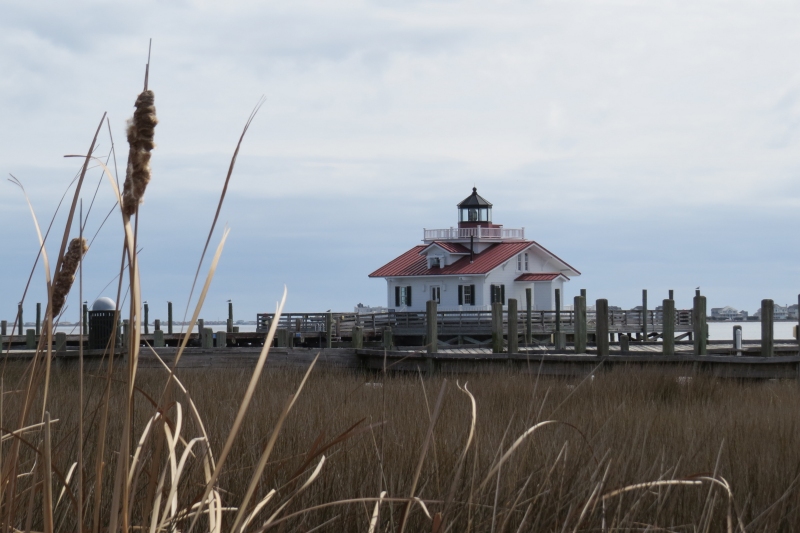Looking for the Lost Colony – Roanoke Island, NC
/Welcome to Fort Raleigh
While in the Outer Banks, we were quite interested in visiting Roanoke Island, noted for its centuries' long mystery regarding the Lost Colony. We drove across the Croatan Sound bridge to Fort Raleigh on the northeast end of the island. It was early. There were no cars in the parking lot except for the on-duty ranger. We had the place to ourselves.
We watched an engaging, well-produced video about the Lost Colony and the building of Fort Raleigh before taking a few minutes to explore the small, but informative museum. The video refreshed our early American history about Sir Walter Raleigh's efforts to establish an English colony in the newly “discovered” America and the establishment of the Roanoke settlement.
Fort Raleigh National Historic Site Visitor Center Museum
All that was found of the Roanoke Colony was an abandoned site and a palisade at the fort with the word "Croatan" carved on it.
A quick recap of events … In 1587, led by John White, a friend of Raleigh, 115 colonists comprised of men, women and children were enlisted to establish a colony on Chesapeake Bay. For unknown reasons, they were deposited at Roanoke Island. A prior British exploring party had not made a favorable impression on the locals and the new settlers had “Indian troubles” and were severely short of supplies and food. John White returned to England to get help and promised supplies, but the English were at war with France and Spain (how unusual) and had no time or supplies for the stranded colonists. John White returned three years later to find no trace of the settlers and the word “Croatan” scratched on a palisade timber. For the past four centuries, historians and archeaologists have postulated all sorts of theories and tried to solve the mystery without any conclusive results, although a 2015 NY Times article indicates there might be some progress.
The museum spread a little light on other events that occurred on Roanoke Island besides the loss of a colony and its inhabitants. For instance, Reginald Tessenden, resident of Roanoke Island at the time, was the first person to send a wireless voice transmission (radio). Roanoke Island was used by the Union as a prison camp for captured Confederates soldiers and was also a Freedmans Colony for emancipated slaves. Pretty impressive for such a little island.
A short nature trail led us past the reclaimed earthworks of Fort Raleigh, built by the original colonists as a protection from the aggressive locals.
Reconstructed earthworks from Fort Raleigh
We walked to the Lost Colony Theater which was open to wandering visitors, but not yet in production for the 2017 season. With the Albermarle Sound as a backdrop, it looked like a great venue for Paul Greene's Lost Colony touted as “the nation's longest running outdoor symphonic drama, performed since 1937”. It might be worth returning for.
The venue for the Lost Colony Theater seemed so perfect.
We wandered along well-worn paths and trails and ended up at the Elizabethan Gardens. They looked inviting, but we reckoned it was a bit too early for the gardens to be at their peak, so we took a miss.
It was too early in the season to be able to appreciate the Elizabethan Gardens, but the entrance was appealing.
On our return to the Visitor's Center, we heard, midst the chatter of several frenzied squirrels, a distinctive cardinal's song and looked up to see a brilliant red male singing cheerily as we passed.
We worked our way back to Manteo, the largest town on the island, in search of lunch. It's still early in the season, so many of the shops and restaurants were closed. Still, it's an appealing little town with lots of little shops and cafes along the main street and a classy boardwalk edging the Sound. The streets are named after the original colonists and notable Brits. There's a nice little marina which we learned could accommodate Nine of Cups.
As we wandered, we came upon the very photogenic Roanoke Marshes Light, a reconstructed screwpile lighthouse opened in 2004.
Roanoke Marshes Light
After a leisurely lunch at the Lost Colony Brewery Cafe (how appropriate), we reluctantly began the trek back to Chesapeake. We managed a quick stop at the Jockey's Ridge State Park to view the east coast's biggest sand dunes. Though the park was lovely, we weren't all that impressed. After sliding down the dunes at Great Sand Dunes National Park in Colorado and climbing the world's tallest sand dunes in Namibia, these dunes didn't do much for us. I guess we're a bit jaded.
The trip back was uneventful except for this one photograph which required a u-turn to get. I couldn't resist.
A little rusty Americana
So what did I learn this trip?
Lots! But shame on me! I was aware of Roanoke Island's ill-fated Lost Colony, but I always thought Roanoke Island was in Virginia, not North Carolina. There is a Roanoke, Virginia, but no Lost Colony there.
Some great trivia ... General Ambrose Burnsides, Civil War Union general, had an unusual facial hair arrangement which started a new trend. Today, we call them “sideburns” vs. burnsides!













